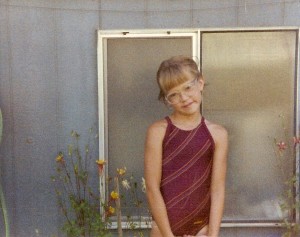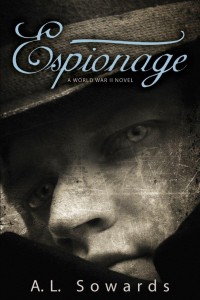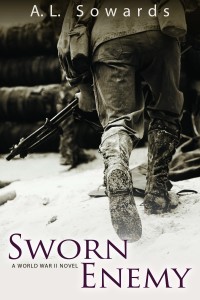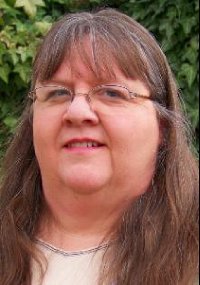Amanda Sowards, who writes under the moniker A.L. Sowards, is developing a niche for herself–World War II espionage thrillers. Although she hasn’t been at it for very long, she’s already receiving recognition. Her debut novel, ESPIONAGE, was a 2012 Whitney Finalist, and I wouldn’t be surprised if her follow-up, SWORN ENEMY, is similarly lauded.
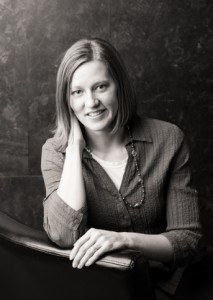 ME: How old were you when your family moved to Moses Lake, Washington, and what was it like growing up there? (I’d love a picture of you as a child there.)
ME: How old were you when your family moved to Moses Lake, Washington, and what was it like growing up there? (I’d love a picture of you as a child there.)
AMANDA: I was two when we moved there. Moses Lake has grown, and it seems massive when I compare it to Manassa, Colorado (where my husband grew up), but while I was living there it just seemed like a typical small town surrounded by lots of farms. Sometimes we called it Moses Hole instead of Moses Lake, but you can only get away with that if you’ve actually lived there. Despite our less-than-flattering nicknames for it, most of us had significant hometown pride.
ME: Which came first for you . . . swimming or writing? Please describe your introduction to each, plus the main storyline of your first story.
AMANDA: Probably swimming, if you count swim lessons. My aunt gave me my first swim lesson when I was about three months old. (Wow! You were practically born to the water.) Then I took swim lessons for a few years and started swimming competitively the summer after first grade. Back in those days, my life’s ambition was to be a lifeguard. My goals have changed a lot since then, but I did work a summer as a lifeguard, knowing it was just a summer job and not something I wanted to make a career out of.
My dad was asked to visit a new couple in our church congregation and he encouraged my mom to visit them too. My mom had four kids under the age of nine (two more would come later), so the last thing she wanted to do was add something to her to-do list. (I can well imagine!) But she went, and the wife was going to coach on the swim team that year, so my mom signed me up. The next year my older sister joined, then the year after that my younger sister started swim team. All six of us ended up swimming with our local swim team and our high school team. Four of us swam for BYU with at least partial scholarships.
(A family legacy, eh? I imagine you’ve already got your twin toddlers signed up for swimming to carry on the tradition.)
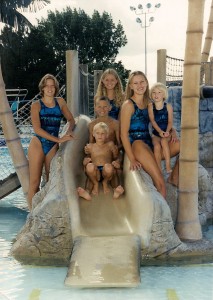 (Amanda, left, with her siblings . . . the youngest is now at the MTC)
(Amanda, left, with her siblings . . . the youngest is now at the MTC)
I think my first book was about two friends who were riding bicycles. It wasn’t very long. I may have illustrated it with crayons.
(I think we can tell which activity was at the forefront in your early years. :D)
ME: However did you manage to attend a writer’s conference as a third grader?
AMANDA: It was a young writer’s conference, designed for elementary school children. It must have been an annual thing because I remember going in 5th and 6th grade too, and never having enough money for the bookstore.
ME: I, too, developed a love for all things World War II in high school. Tell us about your History and English teachers and how they affected you.
AMANDA: I’ve been blessed with great teachers. Most of my elementary school teachers encouraged a love for reading, and I’m grateful for that. In sixth grade, several of the teachers (including mine, Mrs. Mabry) did an entire unit on WWII. (How cool!) One teacher gave us history lectures and assigned reports, another taught reading with WWII novels, and the third did a science section on acid rain—kind of a stretch, but it supposedly tied in with WWII because all the bombing created pollution which led to acid rain? I guess we were too young to study nuclear physics and the Manhattan Project.
My favorite history teachers were Mr. Paul and Mr. Frederick. Both taught American history, and made it fascinating. Actually, Mr. Frederick was the one who introduced me to D-day deceptions schemes, and that lead to most of the plot for my fist novel, ESPIONAGE.
I think my best English teachers were Mr. Lindholm, Mr. Teals, and Mr. Robertson. They made us think. And the day Mr. Robertson told us we didn’t have to limit our essays to the standard five-paragraph formula was one of the most liberating of my entire educational experience.
(Yes! A teacher who can think outside the box and–shudder!–lead his students to do likewise.)
ME: Were you writing stories in high school and college, too, or were classes and swimming taking up all your time? And I must have a photo of you in a race, either in high school or at BYU.
AMANDA: The first chapter of ESPIONAGE is actually a story I did for a high school English project. After I finished it, I started thinking more about the main character and came up with ideas about what could happen next. I ended up rewriting the beginning several times (and changing it from first person to third person), but the essential plot elements of Peter’s trip to the Nazi base in France are basically the same as they were when I was a junior in high school. The rest of the book wasn’t written until after college (because I had too many other things to do during those years), but I think some of the plot ideas for later in the book had been in my head since my junior or senior year of high school. I did manage to sneak in a little research, though, in both high school and in college, when we got to choose our own research projects. I did at least two of them on D-day deception schemes, and a few on other WWII topics.
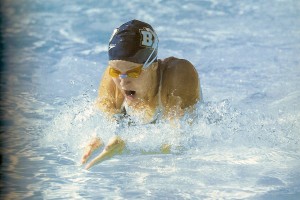 (Amanda racing breaststroke for BYU . . . actually, she faked it for the photographer)
(Amanda racing breaststroke for BYU . . . actually, she faked it for the photographer)
ME: Please share the story of your first book and how it progressed from idea to publication.
AMANDA: I finished a first draft of ESPIONAGE in early 2005 (although it wasn’t called ESPIONAGE at the time—that was Covenant’s choice). By 2006 I had it cleaned up enough that I wanted to look for an agent or an editor. I got the usual rejections, and whenever that happened I went to work on revising it yet again.
In the middle of 2008 I got my first rejection from Covenant via email. They said it didn’t fit their current marketing needs. I figured I didn’t have much to lose, so I emailed back and asked if there were changes I could make to have it better fit their needs. (Take a lesson. Never give up, but use rejections to your advantage.) They sent me the forms from their outside evaluators and I incorporated most of the suggestions and sent it in again. I didn’t hear anything for eighteen months, so I assumed the answer was “no,” but when I got back from taking my newborn twins to their two-week check-up, I had an acceptance email. (Yay!!!) It was almost two years after its formal acceptance that ESPIONAGE finally reached bookstore shelves, but with two infants for me to take care of, that was probably a good thing.
ME: How would you compare it to its sequel, SWORN ENEMY? And what is the main storyline of your third WWII novel?
AMANDA: They’re all WWII spy novels with some of the same characters. I’ve tried to write them so they can each be read without reading the other books, but there is a definite chronological order.
I learned a ton about writing with ESPIONAGE, so with SWORN ENEMY I feel I was able to fix problems earlier in the process and I think my writing has gotten a little better. The characters go through more dramatic growth in Espionage. They change in Sworn Enemy too, but the change is more subtle. Sworn Enemy has more characters and more subplots. I’d also say the “can’t put this book down” part starts a little earlier in the sequel.
Espionage is fun because the history ties into D-day, and that’s something most people have heard about and they recognize its importance in WWII. Sworn Enemy is fun because it deals with aspects of the war most Americans aren’t as familiar with, such as the August 1944 invasion of Southern France (the same campaign Saints and Soldiers: Airborne Creed revolves around), and everything that was happening in Romania at about the same time.
The third book is similar to Sworn Enemy in that Peter and Genevieve are involved in separate subplots. Genevieve is in Bari, Italy for most of the book, and ends up in a spy vs. spy duel with a Italian Fascist assassin. (Sounds exciting! Besides, those of you who have read my bio know I have a thing for Italy.) Peter and some of his teammates from Sworn Enemy (Jamie, Krzysztof, and Moretti) are sent on a mission into Yugoslavia and end up stranded there, where they have to deal with not only the Nazis, but also three different factions in a civil war. The third book is perhaps more emotional than the first two (but there’s still plenty of action), and has a beautiful message about hope, even in times of war.
ME: How many hours of writing can you put in at night once your twins are asleep without feeling like you’re neglecting your husband? In fact, what does he think of your career? (And I’d love a photo of the two of you.)
AMANDA: I try to do most of my writing during “nap time,” which is changing into “quiet time” as my children get older, and often it isn’t all that quiet. On a good day I’ll have two hours. Then I have the evenings to spend with my husband, catch up on my reading, or browse Facebook and blogs. And yes, sometimes I write in the evenings too, especially if I’m on a deadline.
My husband has always been supportive of my writing. It was a hobby I spent several nights a week on when we met, so some of my characters have been part of my life longer than he has. Although he’s not much of a fiction reader, he’ll help me find plot holes and do quick research for me. And he was very understanding the night I spent hours pouring over pictures of WWII soldiers, trying to find a good view of their butts. (Too funny!) I wanted to check the pockets, because I’d just seen the cover for Sworn Enemy, and I loved it, but most army uniforms didn’t have pockets like that. But the Marines did, so close enough, right? (That’s a plausible excuse. Just kidding.)
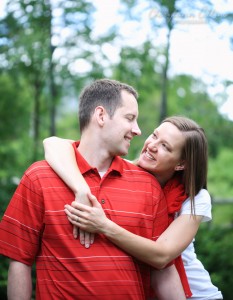 (Amanda with her “understanding” husband)
(Amanda with her “understanding” husband)
ME: What are you currently working on and how would you describe your process? Do you ever see yourself moving beyond WWII fiction?
AMANDA: I’m working on yet another WWII spy thriller, with new characters. I’m hoping to finish the first draft by the end of August. (I’m also hoping to sell my house by the end of August–we’ll see if I manage both.) It’s about two American spies working in Rome in early 1944, trying to gather information for the Allied armies, elude the Gestapo, and avoid falling in love with each other.
(Sounds terrific!)
After that, I want to write something that isn’t WWII, although I have plenty of other WWII ideas–I seem to get a new one with most research books I read. (And, believe me, she reads a lot of them. I have her as a friend on Goodreads.) I’m not sure if I want to do a contemporary suspense novel, or if I want to go back and finish a manuscript set in Serbia in the 1300s. It’s similar to my other books in terms of adventure and romance, but instead of battling Nazis, the characters are fighting the Ottoman Turks.
(Now that really sounds intriguing. My vote is Serbia in the 1300s. There are plenty of contemporary thrillers, but who’s read anything about Serbia in the early middle ages?)
My writing process changes with each novel, but I find that my outlines are getting more and more detailed with each book. And each book is being written a little more quickly than the last one, and I think those two facts are related. (I think you’re right.)
ME: Last of all, please share the five things that make your writing space special and provide a picture.
AMANDA: I can write just about anywhere, as long as my kids are out of my hair for a few hours! I just need my laptop. Sometimes I work at a desk, but usually I put my laptop on my lap, put my feet up on the coach, and type that way. So I actually have a lot of writing spaces: desk, upstairs couch, downstairs couch, bedroom chair (although I had to give that space up when we took the sides off the cribs). We’ll see where I end up writing when we move—I’m hoping to have my desk and my history books in the same room.
What makes these spaces special? My computer, quiet, and easy access to electricity, chocolate, and research books.
(Ah, yes. No five essentials would be complete without chocolate.)
 (One of her several writing spaces)
(One of her several writing spaces)
You can find out more about Amanda on her website or blog, and her books are available at most LDS bookstores or online at Amazon, Barnes & Noble, Deseret Book, and Seagull Book.
Next Wednesday, I’ll be talking with award-winning author and editor, Lu Ann Staheli, who has recently released a great new coming-of-age novel.
Originally posted 2013-08-07 06:00:37.

